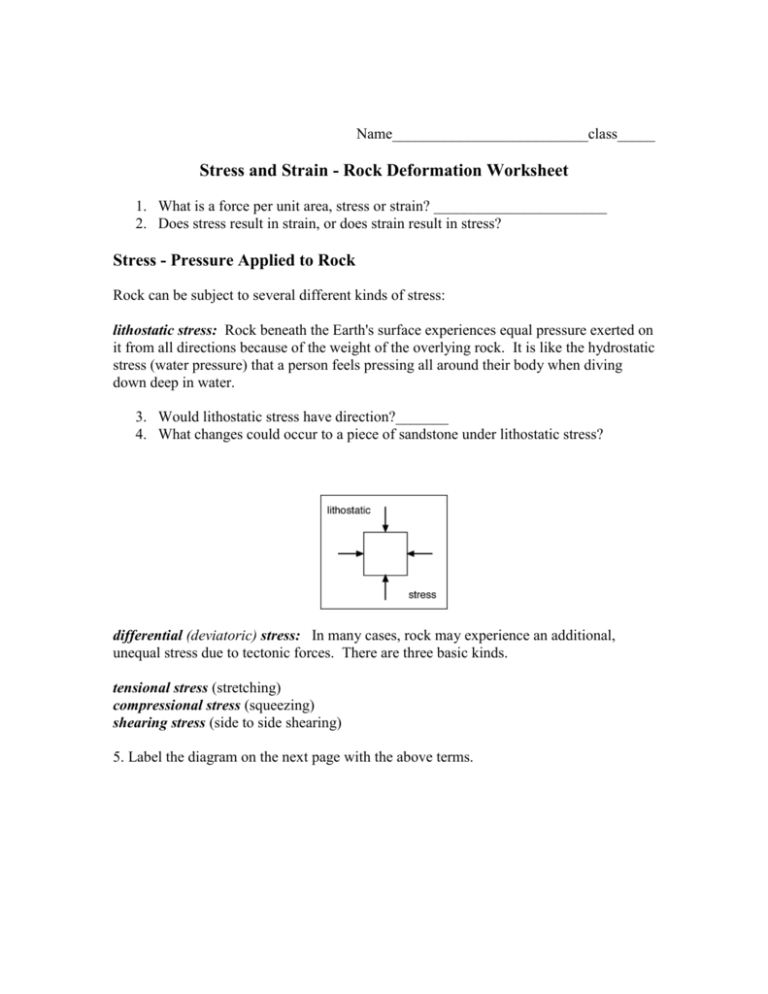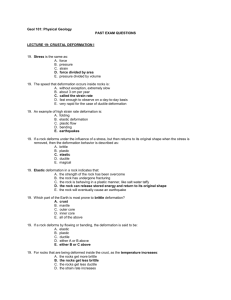Stress and Strain - Rock Deformation Worksheet - H
advertisement

Name__________________________class_____ Stress and Strain - Rock Deformation Worksheet 1. What is a force per unit area, stress or strain? _______________________ 2. Does stress result in strain, or does strain result in stress? Stress - Pressure Applied to Rock Rock can be subject to several different kinds of stress: lithostatic stress: Rock beneath the Earth's surface experiences equal pressure exerted on it from all directions because of the weight of the overlying rock. It is like the hydrostatic stress (water pressure) that a person feels pressing all around their body when diving down deep in water. 3. Would lithostatic stress have direction?_______ 4. What changes could occur to a piece of sandstone under lithostatic stress? differential (deviatoric) stress: In many cases, rock may experience an additional, unequal stress due to tectonic forces. There are three basic kinds. tensional stress (stretching) compressional stress (squeezing) shearing stress (side to side shearing) 5. Label the diagram on the next page with the above terms. Strain - Rock Deformation in Response to Stress Rock responds to stress differently depending on the pressure and temperature (depth in Earth) and mineralogic composition of the rock. elastic deformation: For small differential stresses, less than the yield strength, rock deforms like a spring. It changes shape by a very small amount in response to the stress, but the deformation is not permanent. If the stress could be reversed the rock would return to its original shape. brittle deformation: Near the Earth's surface rock behaves in its familiar brittle fashion. If a differential stress is applied that is greater than the rock's yield strength, the rock fractures. It breaks. Note: the part of the rock that didn't break springs back to its original shape. This elastic rebound is what causes earthquakes. ductile deformation: Deeper than 10-20 km the enormous lithostatic stress makes it nearly impossible to produce a fracture (crack - with space between masses of rock) but the high temperature makes rock softer, less brittle, more malleable. Rock undergoes plastic deformation when a differential stress is applied that is stronger than its yield strength. It flows. This occurs in the lower continental crust and in the mantle 6. On the diagram of the next page, what kind of stress is being applied? Tension or compression?_______________________ 7. Label ductile and brittle deformation Stress-Strain curve 8. How would you describe the relationship between stress and strain as a rock is in the elastic region? 9. What is another name for the plastic region?___________________ 10. Make an X on the graph that shows the maximum amount of stress that can be applied to this material before it can no longer return to its original shape. 11. Draw a line on the graph that shows what will happen to the stress once the rock fractures 12. Different materials have different stress-strain curves. In the bottom chart, which color would represent a ceramic plate, and which would represent a paperclip? 13. How do you know?






